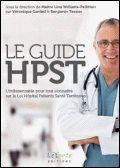LU POUR VOUS D'AVRIL 2010 : livres du mois - sites du mois - working papers
Tous les lu pour vous
LES LIVRES DU MOIS
La loi HPST : regards sur la réforme du système de santé.
Couty E., Kouchner C., Laude A., Tabuteau D.
Rennes : Editions EHESP : 2009 : 391 p.
La loi du 21 juillet 2009 portant réforme de l'hôpital et relative aux patients, à la santé et aux territoires est appelée à modifier en profondeur le système de santé français. Les quatre titres de la loi : Modernisation des établissements de santé, Accès de tous à des soins de qualité, Prévention et santé publique et Organisation territoriale du système de santé font ici l'objet de commentaires rédigés sous la direction d'Édouard Couty, Anne Laude, Camille Kouchner et Didier Tabuteau. Chaque commentaire retrace l'évolution des principales dispositions, au regard de la législation précédente et des débats parlementaires, et s'inscrit dans la perspective des évolutions du système de santé. Ces commentaires sont eux-mêmes prolongés par le regard d'auteurs qui, à l'instar de Claude Evin, Michel Legmann, Jean-Marie Bertrand et bien d'autres éminents spécialistes des questions de santé, livrent leurs réflexions personnelles sur le sujet (4e de couverture).
Loi HPST : analyse & arguments.
Chabot J.-M.
Paris : Global Médical Santé : 2009 : 174 p.
Cet ouvrage se compose de quatre chapitres, correspondant aux quatre titres de la loi Hôpital Patients Santé Territoires – HPST, et pour chacun de ces quatre chapitres, de deux points complémentaires. D'abord, en ouverture de chapitre, un résumé analytique des articles (au total, 135) et des dispositions attenantes contenues dans la loi. Ce résumé signale en particulier les décrets et autres textes d'application qui doivent être publiés en aval du texte légal. A l'évidence, ce résumé analytique est d'une lecture plus aisée que les 91 feuillets du Journal officiel. Ensuite, immédiatement après le résumé analytique, une série de textes courts, qui illustrent et mettent en perspective – comme tenu de la réalité française – l'une ou l'autre des dispositions légales qui viennent d'être évoquées dans le résumé analytique (D'après la note au lecteur.)
La nouvelle loi Hôpital patients santé et territoires : analyse critique et perspectives.
Clément J.-M.
Bordeaux : Les Etudes Hospitalières : 2009 : 131 p.
La nouvelle loi n° 2009-879, du 21 juillet 2009, portant réforme de l'hôpital et relative aux patients, à la santé et aux territoires, dite loi HPST, va bien au-delà du domaine hospitalier, elle concerne l'ensemble du champ sanitaire et médico-social. Ses 135 articles sont d'un abord difficile tant le législateur veut être précis, or il est bien trop prolixe. Beaucoup des lecteurs de ces 40 pages du Journal officiel du 22 juillet 2009 ont été découragés par l'aspect extrêmement aride de cette nouvelle loi. Il faut bien avouer qu'elle modifie énormément d'articles du Code de la santé, mais aussi du Code de la sécurité sociale, du Code de l'action sociale et des familles. La loi HPST est une grande loi de santé publique : pour ou contre, il est indéniable que chacun sera frappé par la volonté du législateur d'impliquer l'État dans l'offre égalitaire et de qualité des soins. De la prévention aux soins chroniques toutes les facettes de l'offre de soins sont concernées et l'État devient le véritable chef d'orchestre de toutes les professions de santé et de tous les offreurs de soins. L'État, par ses services déconcentrés en région, regroupés en agences régionales de santé, va donc régenter l'ensemble du sanitaire et du médico-social. Le lecteur appréciera l'esprit synthétique, mais aussi clair, pour mieux appréhender les différents articles de cette loi, au demeurant importante pour l'organisation de l'offre de soins. Délibérément non exhaustif, l'auteur considère que la compréhension globale prédomine sur l'étude micro-juridique, certes inévitable, mais actuellement prématurée, puisque les décrets et arrêtés d'application sont loin d'être prêts à être publiés. Fallait-il attendre un ou deux ans pour disserter sur cette nouvelle loi ? Non, assurément, car il est déjà plus qu'opportun de permettre à chacun de nos lecteurs de situer cette loi dans la saga des lois hospitalières de ces cinquante dernières années et de comprendre la logique techno-scientifique de ceux qui sont à l'origine de notre système de santé.
Le guide HPST.
Williate-Pellitteri L., Gardeil V., Tessier B.
Paris : Lexanté ; Paris : Santexel : 2009 : 198 p.
Ce guide permet d'appréhender rapidement les dispositions de la loi Hôpital Patients Santé Territoires (HPST). Par une lecture simple de ce guide il est possible de maîtriser les principales thématiques de la loi HPST : la nouvelle organisation des soins optimisée pour les patients (offre de soins de qualité, parcours de soins...), la nouvelle organisation territoriale (ARS) permettant une meilleure complémentarité entre les acteurs du monde de la santé, l'évolution de la notion de service public, la modification du fonctionnement des établissements de santé par la création de nouvelles formes de coopération mais aussi par la nouvelle gouvernance (avec de nouveaux acteurs) centrée sur le projet médical d'établissement.
Voir aussi :
Deux synthèses de l'Irdes
Une description en anglais sur le site d'Health Policy Monitor
Deux dossiers en ligne
- Ministère chargé de la Santé. (M.S.S.P.S.). Paris. FRA
Hôpital, patients, santé, territoires : une loi à la croisée de nombreuses attentes.
Paris : Ministère chargé de la santé : 2009/09 : 51 p. - Fédération des Etablissements Hospitaliers et d'Aide à la Personne Privée non Lucratifs. (F.E.H.A.P.). Paris. FRA
La loi Hôpital Patients Santé Territoires (HPST) : ce que vous devez savoir de la loi pour vos activités sanitaires, sociales et médico-sociales.
Paris : FEHAP : 2009 : 77 p.
LES SITES DU MOIS D'AVRIL
Blog de l'ARS Ile-de-France
www.sante-iledefrance.fr/
Presentation
Ce blog a été mis en place avant l'installation des Ars. Ce blog de préfiguration de l'ARS Ile-de-France donne régulièrement des informations sur la mise en place de l'Agence, des données générales sur des sujets de santé en Ile-de-France, mais aussi de répondre à certaines interrogations suscitées par ce changement profond dans le pilotage régional de la santé. Les acteurs en santé d'Ile-de-France peuvent également interroger le président de l'Ars Une série de liens permet d'avoir une vue d'ensemble sur les organismes œuvrant pour la santé en l'Ile-de-France.
Direction Générale de l'Offre de Soins (DGOS)
www.sante-sports.gouv.fr/hopital.html
Presentation
La Direction Générale de l'Offre de Soins (DGOS) se substitue depuis le 16 mars 2010 à la Direction de l'Hospitalisation et de l'Organisation des Soins (Dhos). La création de cette nouvelle direction traduit la volonté d'une approche globale de l'offre de soins, intégrant aussi bien la ville que l'hôpital, en complémentarité avec les autres directions d'administration centrale compétentes en matière de politique de santé. Dans l'espace consacré à cette nouvelle instance sur le site du ministère de la santé, on trouve les grands axes de ses missions, son organigramme, les chiffres clés de l'offre de soins. On accède également aux actualités de la DGOS ainsi qu'un à agenda des colloques qu'elle organise. Cet espace regroupe tous les dossiers actuellement répartis sur le site internet du Ministère, et offre ainsi plus de lisibilité et de cohérence sur les sujets relevant de l'hospitalisation, de l'organisation et de l'offre de soins.
Portail des ARS
www.ars.sante.fr/Internet.portail.0.html
Presentation
Ce site est une plateforme d'information nationale mais permet également l'accès aux 26 sites régionaux des Agences Régionales de Santé, crées par la loi HPST. Le site national présente les objectifs, les missions, l'organisation et les moyens de ces agences. Il Les champs d'action des ARS que sont la prévention et la santé publique, la veille et sécurité sanitaire, l'offre de soins et l'accompagnement médico-social font l'objet d'une rubrique alimentée par l'actualité. Les deux chantiers prioritaires, à savoir la coopération hospitalière et la lutte contre les déserts médicaux Il mettra également à disposition les rapports sur la santé et les textes réglementaires. Les différents sites régionaux reprennent plus ou moins la structure du site national mais s'adressent également à un public plus large. Ils reprennent notamment les outils en ligne déjà existant et mis en place par l'assurance maladie : le moteur de recherche recherchesante.fr et les bases de données cartosante (cartographie interactive de l'offre de soins) et instalsante (aide à l'installation des professionnels de santé.
VU DE L'ETRANGER : QUELQUES WORKING PAPERS ANALYSES
Assurance maladie
Preferences for Health Insurance in Germany and the Netherlands : A Tale of Two Countries. 

Les préférences en assurance maladie pour l'Allemagne et les Pays-Bas : un rapport sur deux pays.
Zweifel P., Leukert K., Berner S.
Zurich : University of Zurich : 2010/03 : 26 p.
This contribution contains an international comparison of preferences. Using two Discrete Choice Experiments (DCE), it measures willingness to pay for health insurance attributes in Germany and the Netherlands. Since the Dutch DCE was carried out right after the 2006 health reform, which made citizens explicitly choose a health insurance contract, two research questions naturally arise. First, are the preferences with regard to contract attributes (such as Managed-Care-type restrictions of physician choice) similar between the two countries? Second, was the information campaign launched by the Dutch government in the context of the reform effective in the sense of reducing status quo bias? Based on random-effects Probit estimates, these two questions can be answered as follows. First, while much the same attributes have positive and negative willingness to pay values in the two countries, their magnitudes differ, pointing to differences in preference structure. Second, status quo bias in the Netherlands is one-half of the German value, suggesting that Dutch consumers were indeed made to bear the cost of decision making associated with choice of a health insurance contract.
Competition Between HMO and PPO: A Two-Sided Market Approach. 

Concurrence entre HMO et PPO : une approche duale du marché.
Bardey D., Rochet J.C.
Rochester : Social Science Electronic Publishing : 2009/12 : 17 p.
Classical analysis of health insurance markets often focuses on adverse selection, which creates a direct externality between the enrollees of the same health plan: under an imperfect risk adjustment, the higher the risks of my co-enrollees, the higher my cost of insurance. This has lead to the view that restricting the diversity of accessible physicians may be good for policyholders, in a context where competition between health plans can lead to a "death spiral" for the less restrictive plan. This paper defends the opposite view that diversity might pay, because of the indirect externality between policyholders and physicians. By attracting higher risks, the less restrictive plan may also guarantee a higher level of activity to its physicians, and therefore negotiate with them a lower fee-for-service rate. By explicitly modeling the two sides of the market for health (policyholders and physicians), we are able to find examples in which competition between health plans gives a higher profit to the less restrictive plan.
The Effect of Health Insurance Coverage on the Use of Medical Services. 

L'effet de la couverture d'assurance maladie sur le recours aux services médicaux.
Anderson M., Dobkin C., Gross T.
Cambridge : NBER : 2010/03 : 41 p.
Substantial uncertainty exists regarding the causal effect of health insurance on the utilization of care. Most studies cannot determine whether the large differences in healthcare utilization between the insured and the uninsured are due to insurance status or to other unobserved differences between the two groups. In this paper, we exploit a sharp change in insurance coverage rates that results from young adults “aging out” of their parents' insurance plans to estimate the effect of insurance coverage on the utilization of emergency department (ED) and inpatient services. Using the National Health Interview Survey (NHIS) and a census of emergency department records and hospital discharge records from seven states, we find that aging out results in an abrupt 5 to 8 percentage point reduction in the probability of having health insurance. We find that not having insurance leads to a 40 percent reduction in ED visits and a 61 percent reduction in inpatient hospital admissions. The drop in ED visits and inpatient admissions is due entirely to reductions in the care provided by privately owned hospitals, with particularly large reductions at for profit hospitals. The results imply that expanding health insurance coverage would result in a substantial increase in care provided to currently uninsured individuals.
Hôpital
Étude de faisabilité de l'introduction en Belgique d'un système de financement hospitalier « all-in » par pathologie. 

Van de Saande S., De Rick D., De Gauquier K.
Bruxelles : KCE : 2010 : 2 vol (143 ; 293 p.)
L'objectif global de l'étude consiste à évaluer la faisabilité et à comprendre les conséquences et les limites de l'introduction d'un système de financement « all-in » prospectif pour les hôpitaux belges. La faisabilité est essentiellement définie en termes de contraintes au niveau de la disponibilité des données provenant à la fois des enregistrements obligatoires et d'autres sources. Les questions suivantes ont été examinées : Quelles sont les caractéristiques des systèmes de financement par pathologie dans certains pays sélectionnés ? Quels sont les conséquences et les limites d'un système de financement « all-in » en fonction des cas traités? Un système de financement « all-in » par pathologie est-il réalisable pour les hôpitaux belges ?Quel pourrait être l'impact financier d'un système de financement « all-in » au niveau des hôpitaux ?
The Impact of Competition on Management Practices in Public Hospitals. 

L'impact de la concurrence sur les pratiques managériales dans les hôpitaux publics.
Bloom N., Propper C., Seiler S. Van Reenen J.
Bruxelles : KCE : 2010 : 2 vol (143 ; 293 p.)
We exploit a unique dataset and natural experiment to identify the impact of competition on public hospital management practices. We use a new double-blind management scoring tool to interview 161 physicians and managers in English National Health Service (NHS) hospitals, covering 61% of acute hospitals. We find this management measure is strongly correlated with hospital performance as measured by clinical outcomes (e.g. survival rates from heart attacks) and general operational and financial outcomes. We then instrument the number of competing local public hospitals with the share of marginal local political constituencies. In the UK the Government almost never closes public hospitals in political marginals because they risk losing seats in a general election. But they do regularly close hospitals in both their own and the oppositions non-marginal constituencies. Over the period we study the Labor government closed a large number of hospitals, leading to wide variations in hospital concentration levels, which are strongly correlated with whether the constituency was politically marginal. Exploiting this identification we find that product market competition, as proxied by the proximity of other hospitals, is significantly associated with better management.
Inégalités sociales de santé
Reducing the Risks to Health: The Role of Social Protection Report of the Social Protection Task Group for the Strategic Review of Health Inequalities in England Post 2010. 

Réduire les risques liés à la santé : le rôle du rapport du groupe de travail sur la protection sociale dans la revue stratégique des inégalités de santé en Angleterre après 2010.
Glennerster H.
Londres : LSE : 2009/06 : 46 p.
We demonstrate that the introduction of social protection systems as well as their generosity and coverage have significant impacts on health. Who receives the benefits within the household affects the health outcomes for the family. The eligibility for and administration of benefits matters. We examine the growth of means testing in the UK and its recent modifications. We find serious difficulties facing those with long term medical conditions who are on the margins of the labour force. Collaboration between the health and social protection systems is poor. We give particular attention to gender and health and the implications this has for the social protection system. We also consider the fate of groups like asylum seekers who are excluded from its normal working.
Fair Society, Healthy Lives. The Marmot Review Final Report. 

Une sociéte juste, des vies en bonne santé : rapport final de la revue Marmot.
Marmot M.
Londres : University College of London : 2010 : 238 p.
In November 2008, Professor Sir Michael Marmot was asked by the Secretary of State for Health to chair an independent review to propose the most effective evidence-based strategies for reducing health inequalities in England from 2010. The strategy will include policies and interventions that address the social determinants of health inequalities. The Review had four tasks : Identify, for the health inequalities challenge facing England, the evidence most relevant to underpinning future policy and action; Show how this evidence could be translated into practice Advise on possible objectives and measures,,building on the experience of the current PSA target on infant mortality and life expectancy ; Publish a report of the Review's work that will contribute to the development of a post- 2010 health inequalities strategy.
Measuring the impact of health insurance on levels and trends in inequality. 

Mesurer l'impact de l'assurance santé sur les niveaux et les tendances en matière d'inégalité.
Burkhauser R.V., Simon K.I.
Cambridge : NBER : 2010/03 : 38 p.
A substantial part of the inequality literature in the United States has focused on yearly levels and trends in income and its distribution over time. Recent findings in that literature show that median income appears to be stagnating with income growth primarily coming at higher income levels. But the value of health insurance is an important and growing source of economic well being for American households that is missed by focusing solely on income. In this paper we take estimates of the value of different types of health insurance received by households and add them to usual pre tax post transfer measures of income from the Current Population Survey's March Annual Demographic Supplement for income years 1995-2008 to investigate their impact on levels and trends in measured inequality. We show that ignoring the value of health insurance coverage will substantially understate the level of economic well being of Americans and its upward trend and overstate the level of inequality and its upward trend. As an application of our fuller measure of income, we consider how two provisions of current health reform proposals to expand health insurance affect the level and distribution of economic well being.
Politique de santé
A liberal dose? Health and wellbeing: the role of the state. 

Une dose de libéralisme ? Santé et bien être : le rôle de l'Etat.
Reeves R.
Londres : Department of Health : 2010/01 : 50 p.
The role of the state in health and wellbeing is a complex and controversial issue. A difficult question for any government is how far to intervene in the choices and behaviour of individuals in order to promote their own, or others', health. Good health is a vital ingredient of a good life – but so is freedom. This report sets out evidence for what the public think about this question, explores the key issues at stake and clarifies principles for state intervention, suggests a new framework to guide decision making; and proposes a new narrative for future state intervention.
Influencing public behaviour to improve health and wellbeing. 

Influencer le comportement du public pour améliorer la santé et le bien être.
Mulgan G.
Londres : Department of Health : 2010/01 : 40 p.
This independent report builds on current approaches, using the latest evidence from areas such as behavioural economics and psychology, to suggest ways in which the Government could become more effective in this area, to help people to make healthier choices where they wish to do so.
Enabling effective delivery of health and wellbeing. 

Permettre une offre de soins de santé et de bien être efficace.
Bernstein H., Cosford P., Williams A.
Londres : Department of Health : 2010/01 : 45 p.
This independent report offers recommendations to the Secretary of State on how better to enable the delivery of improved health and wellbeing. The terms of reference for this report requested an assessment of the current opportunities and barriers in delivery systems, to identify where practical changes could be made to improve effectiveness.
The impact of the NHS market: an overview of the literature. 

Un panorama de la littérature concernant l'impact du NHS orienté vers le marché
Brereton L., Vasoodaven V.
Londres : Civitas : 2010/02 : 60 p.
NHS ‘internal' or ‘quasi' market policies in England have aimed to promote competition among providers in the hope of replicating the benefits markets have been known to bring about in the private sector: decreases in cost, and increases in efficiency, quality, innovation, and provider responsiveness. This briefing presents the results of a large-scale literature search on the effectiveness of these policies over the past 20 years.
Qualité des soins
Getting the measure of quality. 

Prendre la mesure de la qualité.
Raleigh V.S., Foot C.
Londres : King's Fund Institute : 2010 : 32 p.
Quality has been at the centre of recent NHS policy, and the NHS Next Stage Review highlighted the role of information and measurement in supporting quality improvement, particularly in relation to patient safety, clinical effectiveness and patient experience. It is therefore important to be clear how quality can be measured and by whom – and how the information can be used to improve services. If quality measurement is going to have greatest impact, all those involved – policy-makers, commissioners, board members, managers and clinicians – need to be aware of the opportunities and challenges it presents. This report offers information about how quality is defined and how quality measures can be used – and misused. It sets out the main debates and choices faced by those involved in measuring and using data on quality and outlines some practical issues to be considered in choosing and using quality measures.
Quality of Healthcare in Canada: A Chartbook. 

La qualité des services de santé au Canada en graphiques.
Sutherland K., Leatherman S.
Ottawa : Canadian Health Services Research Foundation. : 2010/01 : 239 p.
The Canadian Health Services Research Foundation has released Canada's first-ever chartbook on healthcare quality. Providing both domestic and international data, the chartbook reports on six key domains of quality: the effectiveness of the healthcare sector; access to healthcare services; the capacity of systems to deliver appropriate services; the safety of care delivered; the degree to which healthcare in Canada is patient-centred; and equity in healthcare outcomes and delivery.
Effective Governance for Quality and Patient Safety in Canadian Healthcare Organizations. 

Une gouvernance efficace pour la qualité et la sécurité des patients dans les organismes de santé au Canada.
Ross Baker G., Denis J.L., Pomey M.P., Macintosh-Murray A.
Ottawa : Canadian Health Services Research Foundation. : 2010/01 : 239 p.
Commissioned by the Canadian Health Services Research Foundation in partnership with the Canadian Patient Safety Institute, this report, prepared by a team of researchers led by Ross Baker, explores the structures, processes and tools used by effective governing boards of healthcare organizations, and the strategies and tactics that can be employed by boards in their efforts to improve governance for quality and patient safety. The report also offers recommendations for board members and executives of healthcare organizations and for policy makers.
Soins de long terme
Long-Term Care Financing Reform: Lessons from the U.S. and Abroad. 

La réforme du financement des soins de longue durée : leçons des Etats-Unis et de l'étranger.
Gleckman H.
New York : The Commonwealth Fund : 2010/02 : 33 p.
As part of health care reform, Congress is considering the Community Living Assistance Services and Supports (CLASS) Act. The measure would mark the most significant change since 1965 in the way the U.S. finances long-term care, the personal assistance delivered both at home and in nursing facilities to the frail elderly and other adults with disabilities. As policymakers consider the CLASS Act, they may be able to learn from past experiments in the U.S. as well as from the experiences of other major industrialized countries, most of which have migrated to universal, government-run financing systems. Although those models vary markedly in their specifics, they appear to be both broadly popular and somewhat more costly than expected. By contrast, the CLASS Act is a voluntary system that attempts to meld public insurance with private long-term care coverage and Medicaid.
Soins de santé primaires
Accessibility and continuity of care : a study of primary healthcare in Quebec. 

L'accessibilité et la continuité des services de santé : une étude sur la première ligne au Québec.
Pineault R., Levesque J.F., Roberge D., Hamel M., Lamarche P., Haggerty J.
Québec : INSPQ : 2009/03 : ix+86 p.
Cette étude, menée dans deux régions socio-sanitaires du Québec, Montréal et la Montérégie, porte sur les modèles d'organisation des services médicaux de première ligne et leur influence sur l'accessibilité et l'utilisation des services de santé par la population ainsi que sur l'expérience de soins des utilisateurs des services. Le principal but de l'étude est d'identifier les modèles d'organisation des services de première ligne les mieux adaptés et les plus prometteurs pour répondre aux besoins et aux attentes de la population.
Primary Care and Emergency Departments. 

Soins primaires et services d'urgence.
Carson D., Clay H., Stern R.
Londres : Primary Care Foundation : 2010/03 : 102 p.
The Primary Care Foundation was commissioned by the UK Department of Health in May 2009 to carry out a study across England of the different models of primary care operating within or alongside emergency departments. The aim was to provide a viable estimate of the number of patients who attend emergency department with conditions that could be dealt with elsewhere in primary care.
Technologies médicales
Achieving Efficiency Improvements in the Health sector through ICTs - Final report. 

La réalisation de gains d'efficience dans le secteur de la santé au moyen des technologies de l'information et de la communication.
Organisation de coopération et de développement économiques. (OCDE). Directorate for Employment - Labour and Social Affairs. (D.E.L.S.A.). Paris. FRA
Paris : OCDE : 2010 : 117 p.
This report presents an analysis of OECD countries' efforts to implement information and communication technologies (ICTs) in health care systems. It provides advice on the range of policy options, conditions and practices that policy makers can adapt to their own national circumstances to accelerate adoption and effective use of these technologies. The analysis draws upon a considerable body of recent literature and in, particular, lessons learned from case studies in six OECD countries (Australia, Canada, the Netherlands, Spain, Sweden, and the United States), all of which reported varying degrees of success deploying health ICT solutions.






